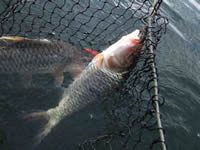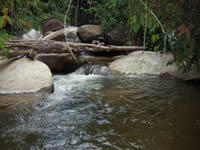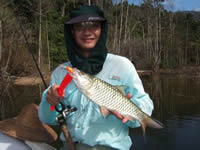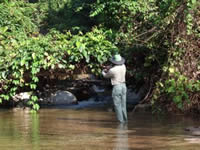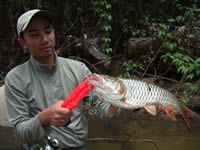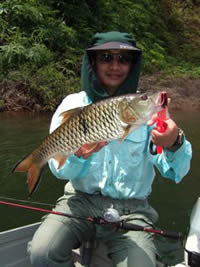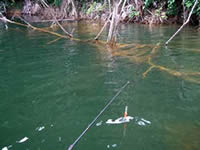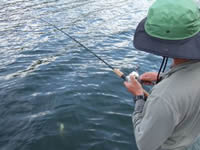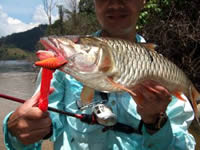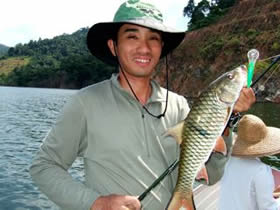
Merdeka Celebrations
by Christopher S.G. Tan
The moment leading up to our Merdeka Celebrations was raised to a fevered pitch with crowds gathering in Kuala Lumpur and Putrajaya to witness the events organised to celebrate the historical occasion. The massive jams leading to these events were testimony to the numbers attending the events.
Some of us however had a different way of celebrating the momentous event. We headed the other direction, away from the jams and bustling crowds to celebrate in our own way by enjoying the Malaysian flora and fauna in the more remote parts of our country. We were not the only ones with the same idea as we saw two other vehicles loaded with fishing gear and a boat, each heading out of town too.
Though we made an early start, we ended up quite late at our destination. We encountered a bit of trouble finding our fishing spot. The “kampung” roads were a bit confusing and of course there were no signboards that kindly said “Fishing Hole turn here”. Many of the locals were not familiar with our destination but eventually we did find our fishing hole.
The launching spot was steep and we chocked the wheels of the 4x4 with some big stones before commencing our unloading of the boat and engine. To see one’s vehicle roll into the water and disappear is never a good start to a day’s fishing. It may be amusing when viewed on a TV home video show or YouTube but not in real life. So the hand brake was pulled tight and the second gear engaged to provide additional braking.
It was already after eight in the morning and with the sun shining brightly we raced to the upper reaches of the dam. I had hoped that the perfect fishing weather I had observed throughout the week would continue on Merdeka day, but it was not to be. Perfect fishing weather for me is a nice overcast day, all day. Maybe a little drizzle or rain for a short while to keep things cool would have been good for us, but I suppose for the parades and air shows it was perfect Merdeka day weather.
Upon reaching the upper part of the dam, we looked around for a good place to start fishing. Shutting off the engine, we could clearly hear the sound of running water. It was quite loud. It came from an inlet nearby. Restarting the engine I cruised slowly to it, then shut down the engine upon reaching the entrance of the inlet and brought the electric trolling motor into play. My plan was that we should slowly go in and cast along the banks and structure before reaching the stream mouth. Ong on the other hand had other ideas. He said, “what are we waiting for? Let’s go straight in and fish the prime spot!”.
So in we went, only stopping to resume casting just outside casting range of the stream mouth that fed into the dam. The loud sound of flowing water came from just above the stream mouth where the water cascaded down from a rocky steep ravine. That clean fast water flowing into the dam sure looked good. Definitely good for sebarau. We were sure there must be some around.
We cast to the banks and submerged tree trunks near the stream mouth. Finally when we could cast to the water flowing in from the stream into the steep drop below the stream mouth our anticipation was high, but we still did not get a single bite. That was strange. Normally we would at least have some follows from small sebarau in an environment like this.
By this time we had drifted right in, next to the stream mouth and we were casting everywhere. Being where we were, it was mostly now downstream of the stream mouth. Suddenly without any warning, I had a jarring hit! Quickly cranking and pumping without giving in any leeway I brought the sebarau in closer. What else could it be, only the the sebarau hits and fights that furiously.
In the midst of my own excitement, Ong gave a whoop and he was on too! Double hook up! The sebarau were not big so they were quickly brought in and unhooked. Both of them were about the same size, 25 cm in length. Obviously they were schooling together.
Hoping the remainder of the school was still around, we renewed our casting. This time it was with more vigour as we now had hope. We had cast for a few minutes when I saw a swirl far down stream. Casting as far as I could, the lure landed a metre short and a metre right of the swirl. Cranking my red tilsan bass at a moderate to fast pace, the hit came about a metre or two from its touchdown location.
Not only was this a hard hitting sebarau, it felt bigger than normal! It had weight behind its tugging. Ever aware of the fish losing snags all along the old stream bed to the boat, I did not stop fighting the fish. Continually pumping the rod and cranking the reel the fish was kept coming to the boat, interspersed with short runs that were brought short with the heavy pressure continually applied. The new Abu Revo reel with its large high powered gearing made applying this pressure easier than with the older reels equipped with smaller main gears.
Like the earlier catch, this one became a double hook up too. This time it was Patrick’s turn. As my catch neared the boat, he too hooked up just before his tilsan bass neared the boat. Now we had two nice sebarau to land. Mine was ready to land first and Ong netted it. With my sebarau in the net, Pat’s sebarau was now also on the surface ready to be landed.
The quickest solution was to double net the sebarau as the landing net was very large. So with my first sebarau still in the net, Ong and Pat managed to get the second sebarau in the landing net. More whoops of joy filled the air with another successful double hook up. These two sebarau were much bigger!
These larger sebarau were also obviously hunting together, cruising around looking for food. Maybe they were in a school too, but we did not get anymore bites though we continued casting. One thing I still found strange was the lack of small sebarau that we normally would commonly catch in stream mouths like this. Normally they would chase our lures almost half their size. Often these small sebarau can be seen patrolling the drop off immediately in front of the stream.
To see if there were any small sebarau hidden away, I pulled out my small sebarau lure to see if there were any takers. To my surprise there were no interested parties tailing it at all. Deciding that maybe they were stacked up right against the water falling down off the rocks, Pat and I waded up the short way to the mini falls and cast beneath the logs to reach the “fish holes” where the sebarau might be waiting for the fish to “fall” into their eager mouths.
True enough, we had a couple of small sebarau chase our small lures, but did not hook up any. The small sebarau learnt fast and would only chase the lures once or twice.
It was now mid morning and the anglers were bored. The cry went out, “Let’s explore more and find a new place to fish”. So off we went, looking for any other likely looking valleys that might lead to another stream. We found one round the next bend. We could hear the soft gentle sound of running water in the distance.
Fishing the structure outside, Pat got a hit that snagged immediately on some deep branches. When we recovered his lure, we discovered that the front hook had disappeared. The split ring was intact and in good shape. So we could only assume that whatever hit the lure (probably a big sebarau) had broken off his single hook at the eye of the hook.
Casting with renewed vigour we worked our way right to the stream mouth. I managed to get a cast to land the lure right on the shallow stream and as I cranked the lure it slid off the sandy edge and swam down into the deep drop off and bang! Fish on! Now that is the way it normally happens. The sebarau was power cranked in fast. In these snag infested waters, we dared not give an inch to the fish.
Often we spent a good amount of time recovering the lures from the branches we would snag. This is part and parcel of lure fishing in snaggy waters. But then snaggy waters are also where the sebarau reside.
Though we worked the area more, that was it. No more bites. Proceeding round the next bend, we came across a shallow area filled with submerged dead grass. When the water was low, the grass grew, and when it was flooded the grass died. I was just saying “From mine and other’s experience, we never get fish from dead and decaying vegetation.....” when Ong exploded with a yell! “Big one, there!” When we finally figured out what exactly the big one was, the kilo plus sebarau Ong saw cruising by the boat in the shallows had scooted away, probably spooked by the boat
Well so much for my “never” statement. There are always exceptions to the rule, though the “never get fish” part still stood. We did not catch anything from the dead submerged grass, and not for the lack of casting.
Around the next bend the valley looked promising. However there was a lot of dead brush littering the valley and the water had a lot of suspended brown matter clouding it up. We made our way in, bashing through the now dead and brown bushes, but could not find a stream feeding in, though we were sure there would be one somewhere. It was just too dense with dead bushes to find it.
Our next sojourn was near the dam wall where there were some big rocks that made for some interesting looking structure. Working our lures over the rocks Pat accounted for two normal sized sebarau and I managed to get one.
By now it was past midday and we decided to head back to the first stream for lunch, but first we made our casts, just in case there were some sebarau lurking around. There were none. We pushed our boat up the stream to the shade beneath the logs. It was perfect. Shady and cool. The steep drop of the stream above us brought down a very relaxing cooling breeze. We had the ideal place for lunch, shade, a boat to sit in and natural airconditioning. We rested there for almost two hours before heading out to face the mid-afternoon equatorial heat.
We did our requisite casts in the old stream bed before heading out but to no avail. Puttering round the corner we spotted some shady spots. After about some 10 casts to the area, I suddenly felt my crash deep diving lure Poltergeist +8m lure suddenly come to a stop. Then my rod took a deep bend and I knew I had a nice fish on the other end. Lifting the rod to recover line and then lowering while cranking the reel as hard as I could, I suddenly felt that it had snagged. Nothing was moving.
Keeping the pressure tight I reversed the boat over the snagged fish and put as much pressure as I could to pull the fish out of the snag. In between putting the pressure, I felt some tugs. That was a relief, to know the fish was still there. Finally I felt something give way and the fish was free, being pumped up. When it came in to sight, Patrick was so entranced by the fish that he just stood there. When I yelled at him to get the net, he got over his immobility and slipped, then fell in the boat with a huge crash. That probably scared all the sebarau nearby into hiding.
The sebarau was landed and released without anymore mishaps. We thoroughly covered the area but had no bites. The blame was put on the big noise created earlier on. Next we moved over to some cliff like rocky areas and it was Pat’s turn to score a sebarau. Though we were not getting sebarau in quantity, we were getting some quality sebarau and in a wide variety of places.
The next three hours were fishless. We fished all sorts of structure along the banks and also moved back and forth between the 2 streams. We spent the last hour at the first stream mouth. Between casting for sebarau beneath the stream mouth we also used small lures to catch a couple of small sebarau. It was an enjoyable time just to hang out at such a pleasant place.
On our way back the last stop was the rocks. This was where Ong got some action after his quiet ten hours. The first sebarau straightened the hooks on his small sorcerer 52. The next hook up broke the front single hook on his tilsan bass. It was not his day. The last fish, the typical sebarau size commonly caught was by Pat. What a splendid way to spend Merdeka. I wish everyday was Merdeka day.
Conservation
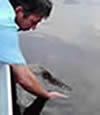
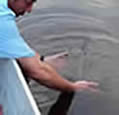
We need to protect and conserve our resources by practising catch and release of our sportfish and protecting the habitat of our fishes.
